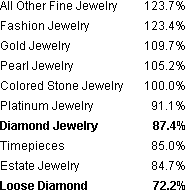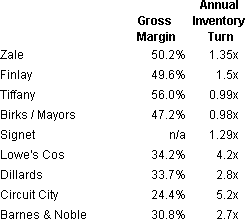IDEX Online Research: How Low Can You Go?
May 07, 07
Jewelers’ margins are too high, and their inventory turn is far too low, according to an analysis of jewelry industry financial data by IDEX Online Research. As a result, jewelers’ return on capital invested in inventory is abysmally low. Investors, banks, and accountants already know that. It is jewelers who don’t understand the problem.
The “problem” can best be understood by measuring jewelers’ GMROI – an acronym for Gross Margin Return on Inventory Investment. The concept is this: how much profit is being generated by merchants’ inventory?
A few savvy jewelers – and their bankers – have embraced the concept of GMROI. GMROI is typically calculated by dividing gross profit dollars by average inventory value, though there are some variations to the calculation, depending on which accountant is doing the books. The bottom line of the GMROI measure is that it provides a realistic view of investment returns on capital deployed for inventory.
A high GMROI is desirable.
How GMROI Works: An Illustration
Here’s a real-life illustration of the power of GMROI to measure a jewelers’ real return on inventory investment.
As a jeweler, you get to choose between these two alternatives. Both assume that you buy an item at a wholesale (all-end) cost of $100; both assume that you keep only one item in stock (you’d need to deal with a supplier like Stuller to make this work properly). Which would you choose?
- Alternative 1: You sell your $100 item with a keystone (50 percent) gross margin, yielding a retail price of $200, with an inventory turn of once per year (this is the current jewelry industry operating model).
- Alternative 2: You sell your $100 item for $101 (roughly a 1 percent gross margin), but with an inventory turn of 365 times per year. In other words, you sell one of these items each day of the year.
Most jewelers would choose Alternative 1; after all, that’s how they currently do business. Smart, savvy merchants would choose Alternative 2. Here’s why:
At the end of the year, Alternative 1 yields total gross profit dollars of $100 on an inventory investment of $100. At the end of the year, Alternative 2 yields gross profit dollars of $365 on an inventory investment of $100. Clearly, Alternative 2 generates far greater gross profit dollars for the merchant.
The Real World
Retailing is inefficient, and our illustration assumes near-perfect financial efficiency. Merchants would probably incur some extra costs to keep their inventory turning 365 times per year, but there would be significant profit leverage, even after incurring these incremental costs.
Further, jewelers’ bankers would probably take a dim view of a merchant who reported a gross margin of 1 percent. However, many businesses operate with a gross margin in that range. Wall Street brokers typically take about 1 percent of the total value of each stock trade; that’s a 1 percent gross margin. If the velocity of inventory movement is high enough, a smaller margin will generate greater profits; that’s why most Wall Street firms and banks post generous profits.
GMROI Comparisons
When jewelers’ GMROI is compared to some other mass market mainstream retailers, such as Circuit City (consumer electronics), Lowe’s Companies (home centers), and Dillards (department store), it is clear that the GMROI of jewelers is below the average of other mass market retailers. The graph illustrates the disparity in GMROI.
GMROI Comparisons 2005
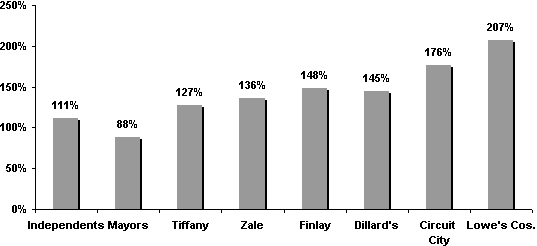
Source: Company Reports
| U.S. Jewelers |
Jewelers’ GMROI for diamonds is among the lowest of any of the product categories that merchants carry, according to the most recent data from Jewelers of America’s Cost of Doing Business Survey. For diamond jewelry, the GMROI was 87.4 percent in 2005, the lowest of any category. For loose diamonds, the GMROI was 72.2 percent, also a below-average level. The table summarizes the GMROI for U.S. jewelers’ major product categories, ranked from highest to lowest GMROI.
Falling Diamond Margins Hurt Overall Profitability
In 2005, the sales mix of loose diamonds and diamond jewelry fell to about 48 percent of the typical U.S. specialty jeweler’s revenues, according to statistics from Jewelers of America. In 2004, these two categories represented about 50 percent of total sales. Unit sales were probably about flat, but heavy price discounting at retail likely accounted for most of the sales mix decline.
However, for many chain jewelers, their diamond sales mix is much higher. As a result, their corporate gross margins have become increasingly squeezed because diamonds and diamond jewelry sales generate a greater portion of their total revenues. The graph illustrates the diamond sales mix for key U.S. publicly held jewelers.
Diamond Jewelry Sales Mix Major U.S. Jewelers - 2005
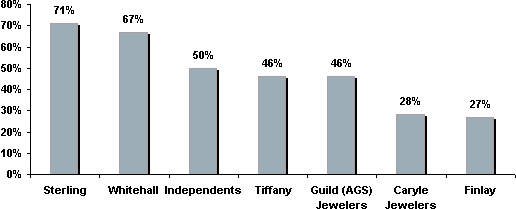
Source: Company Reports
Low Inventory Turn Drags Down Jewelers’ GMROI
For the typical U.S. retailer, the operating model calls for a gross margin in the 25 to 35 percent range, with an annual inventory turn of 3x-5x. Jewelers generate a well above average gross margin – generally in the 45 to 50 percent range, but the typical inventory turn for jewelers is near 1.0x, though some of the major chains are able to achieve an inventory turn of 1.3x, or slightly better.
| Retail Comparisons |
The table on the right summarizes gross margins and inventory turns for major publicly held jewelers versus a sample of other retailers.
Merchants have always faced a balance between generating margins and maintaining inventory turns. This is the heart of capitalism’s supply and demand equation. As prices come down, demand typically rises.
The key question is this: if jewelers reduced prices to a level that generated more realistic “retail” margins, would demand rise enough to increase inventory turns and increase pretax profitability?
Up until now, no one wanted to be the first to try to reduce margins in an effort to drive demand. However, the online jewelry merchants are re-writing the economic operating model for the jewelry industry.
The Online Sales Model
Internet retailers have embraced GMROI, and, as a result, operate with much lower gross margins than store-based jewelers, allowing them to offer the same goods at much lower retail prices. Further, online jewelers have very high inventory turns. Because of the favorable terms that these online merchants have negotiated with their vendors, they actually may have negative working capital needs. Online merchants collect their money from the credit card company in two to three days, but do not pay their vendors for at least 30 days after the sale.
In terms of bottom line profits, Blue Nile, a major online jeweler, generates a pretax margin of 10 percent versus store-based jewelers who generate a pretax margin of only about 4 percent.
Online jewelry retailers have cut prices, especially on highly visible, easily comparable items. As a result, product velocity has soared. Further, they hold little inventory; most of their goods are held on consignment. As a result, they have achieved extremely high inventory turn rates, and their GMROI is at the top of the retail range.
The graph below illustrates Blue Nile’s GMROI versus some other mass market jewelers’ financial returns.
GMROI Comparisons for Jewelers
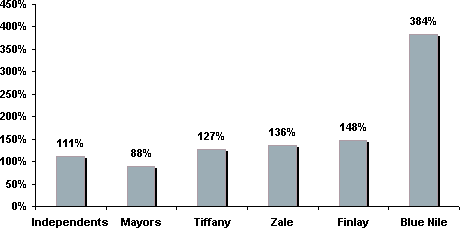
Source: Company Reports
Blue Nile is not an anomaly; Amazon.com also generates a GMROI of 360 percent, far above store-based merchants.
The following table summarizes the gross margin and inventory turns for two publicly held online jewelers as well as Amazon.com. Clearly, gross margins are much lower and inventory turns are much higher. This yields a much higher GMROI.
| Retail Comparisons |
Jewelers’ Reactions to the Online Selling Model
IDEX Online Research has heard many jewelers lament about how online jewelers are stealing business from them. After all, online jewelry sales were about 3.5 percent of total fine jewelry sales in the U.S in 2005. In contrast, online sales of all retail categories (ex-food service and selected others) were only 2.3 percent of the total sales for those categories. Clearly, online jewelry merchants have captured substantial market share.
Here’s what jewelers are saying, and here are some suggested thoughts about their lament:
- “It’s just not fair what those online merchants are doing to my business.” This is capitalism at its best.
- “I can’t get memo.” Get a new supplier.
- “I don’t want memo since the margin is smaller.”
Either we are poor communicators, or you’ve just skimmed this article. Go back to the beginning and read it slowly, word-for-word.
